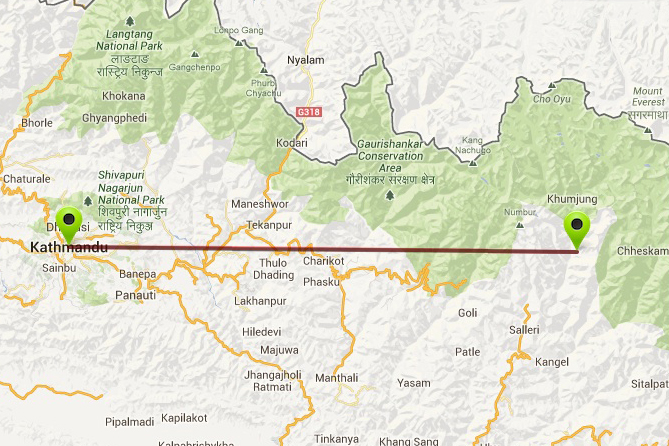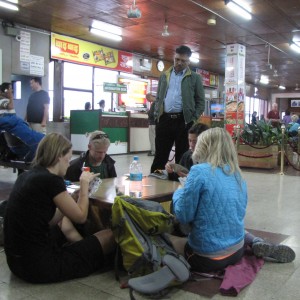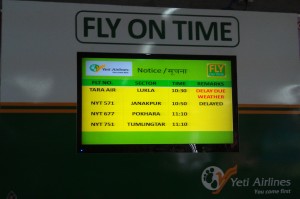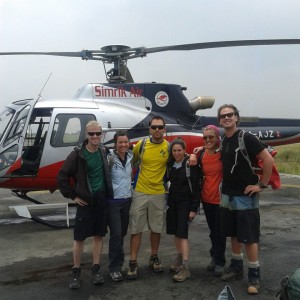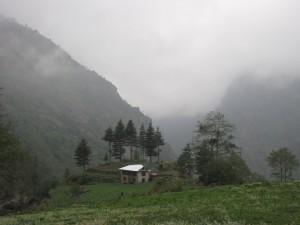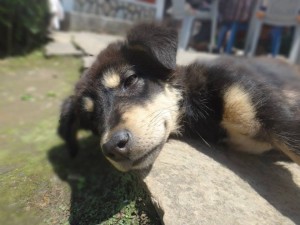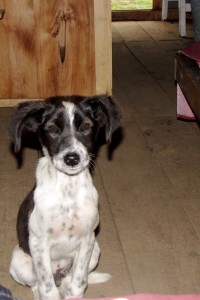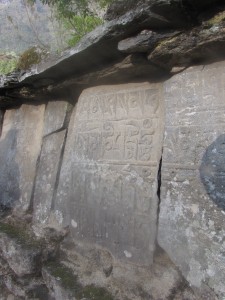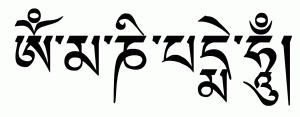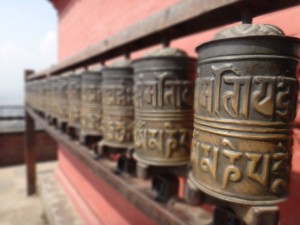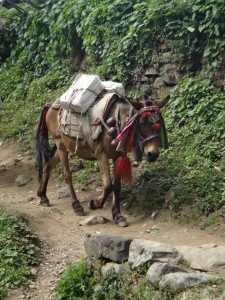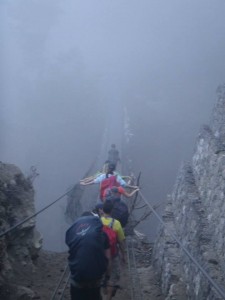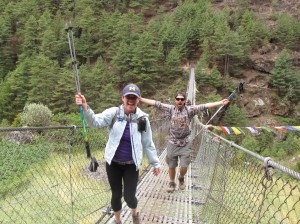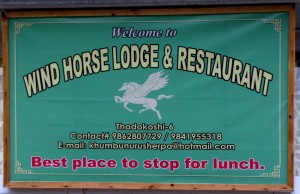We were up at 4 am for a 5 am call time. It was pouring rain, which didn’t bode well for the planned flight to Lukla. To add to the bleary-eyed early morning confusion the hotel experienced one of the routine rolling blackouts that move throughout the city. Dovile and I finished packing by headlamp and then enjoyed our first of many early morning workouts in which it would take our combined strength to squeeze the porter bag closed and force the zipper around. We met the group in the lobby and then loaded up the van for the airport.
The domestic airport consisted of the same rubble, garbage, mangy-looking monkeys and stray dogs that characterized the rest of the city. It hadn’t yet opened so we joined the queue outside. Lucky for us, the rain had lightened up. Kevin was awake enough to observe one of the airlines was called Yeti.
“Their tagline should be ‘Yeti Airlines: We Do Exist!'” he quipped.
We passed through an initial security screening consisting of a baggage scan and pat-down and picked up our boarding passes. One thing unique to this flight is you have a weight limit to your carry-on bag. Each is weighed before a pass is issued. We emptied our water bottles beforehand for this reason.
We went through a similar security procedure a second time to get to the terminal. Once inside we looked at the monitor. So far so good. Our flight was still scheduled to depart at 6:30, the weather must be better in Lukla.
Not long after we sat down, the screen flashed “delayed to 7:30” due to weather. Bummer. We settled in to play cards, read, or fiddle with our phones.
DK had told us earlier that the locals have a different idea of personal space than we westerners. We got a taste of this when a man walked up and began hovering nonchalant over the card game.
7:30 became 8:30. 8:30 became 9:30. DK and Sudip were on the phone and said the weather forecast didn’t look good for the next two days. Rather than stay longer in Kathmandu and repeat this tedious morning ritual the next few days, we unanimously voted to try to hire a helicopter for an extra $200 each. By 11:30 our tickets had been exchanged. We got to leave that day AND we got to ride in a helicopter! The trip just got exponentially more awesome.
Our group wouldn’t fit in one helicopter so Mike, Sara, Kevin, Stacy, DK and I were to take the first flight. Ele, Amanda, Dovile and Sudip would follow in the second. The first six of us went out the back door of the terminal and then piled into a tiny, ancient pickup truck which embarked on a long, scenic drive through the airport to the helicopter landing pad.
We got out of the truck next to a helicopter, took photos, and signed our lives away. Suddenly a whole crew of men showed up and started talking quickly in Nepali. Uh oh, what is going on?
DK tried to call the pilot, a Kiwi he knew named Jason. He told me that Jason was from Queenstown, and flew rescue missions during the climbing season so we’d be in good hands.
Speaking of rescue missions, it turned out that all the commotion was regarding a rescue. Someone up on the mountain wasn’t going to be able to make the walk down and we would have to leave our porter bags behind in favor of more fuel for the mission. The porter bags would go up with the next flight. (Note: This is why it’s a good idea to buy travel insurance. The rescue flight would have cost that person around $5,000.)
They got the fuel issue sorted, we loaded up the helicopter and took off. There were no seat belts or ear protection. Jason was kind enough to open his window for some A/C. We cruised over the colorful buildings of Kathmandu. From the air it seemed like there was a brick smelter on every street corner. On the edge of town we saw an interesting religious statue, big enough to be seen some distance away from the air, though no one knew what it was. After the statue we started to get into the hills, all terraced, still mostly dry and brown.
Eventually the hills got steeper, and greener. We flew into a gorge and were treated to little cascades on either side. My mind started to hum the opening tune to Jurassic Park, especially since we were approaching the most beautiful waterfall yet. Then, just like that, we landed right above it. Wow, really?? I was happier than a slinky on an escalator. (Woo hoo! This is awe-some!)
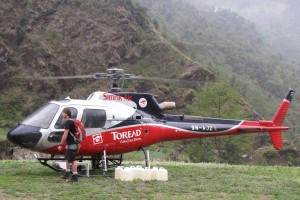
The extra fuel we brought in favor of the porter bags. They unloaded it in Surke to make the helicopter lighter for the flight up on its rescue mission. They’d stop and refuel on the way back down.
I knew we weren’t flying to Lukla, but I had a picture in my mind from the History Channel’s World’s Most Dangerous Airports of what Lukla would be like, and to me this place was a thousand times more beautiful. An organic farmer’s paradise. Surke. (7,513 ft. / 2,290 m). I thought we were already in the mountains, but DK would say later that these were just foothills. 10,000 ft. foothills. We were in the Himalayas!
“HimaYAYA!” Kevin would say. Perfect. It’s in.
The helicopter ride wasn’t exactly short, and I needed to find a toilet. They had one outside of the building and it turned out to be the first of many Asian style toilets I would encounter, and actually come to prefer, on the trail.
We went inside for the first tea break, milk tea (dude chiyaa) this time, and also enjoyed some ramen style noodles for lunch. In this tea house we met the first two of the world’s cutest dogs.
The dogs in Kathmandu, while still cute, tended to be mangy, dusty, and exhausted from barking all night. The dogs up in the mountains were healthy, soft, perky little hiking companions. We petted this skinny pup who was begging for a bit of our soup, while his cousin was outside getting rolled by helicopters and having the time of his life. The other dog would run around barking madly at the choppers taking off and landing and got blown around quite a bit in the process.
Eventually the others arrived, a little weak in the knees since their flight was a bit more exciting than ours, due to both pilot and weather. It was about 2 pm and daylight was becoming a consideration. Surke was about a mile or so below Lukla, our intended starting point, and we also arrived much later than originally scheduled. We had about 5 miles / 8 km to hike. We stayed long enough for them to have some tea and then hit the trail. Including today, it would take nine days of slow and steady acclimatization to reach base camp.
Shortly after departing, DK and Sudip stopped us to give us the rules of the trail. Rule #1: Let animals pass cliff side to keep from being bumped down the side by a mule or yak. Sudip had learned this one the hard way and was kind enough to let us benefit from the experience. Rule #2: Always obey rule #1.
On the trail there would also be cultural rules to follow. Carved prayer stones were everywhere. So were prayer flags. The symbols carved or printed on each represented the sounds “Om mani padme hum” and repeated over and over. We were invited to invoke these sounds and asked to pass the stones on the left, keeping them on our right side. In villages we’d also pass prayer wheels. These were brass cylinders engraved with the same symbols that typically would be spun by hand, though occasionally we’d see one powered by water. We’d spin these toward the direction we were walking, clockwise, though the good energy would be sent in all four directions.
OM MANI PADME HUM is dedicated to the Great Compassionate Chen-resigs, [and] is found inscribed on prayer stones, prayer wheels, prayer flags, and wild rocks throughout the Buddhist Himalaya.
Pronounced in Tibet Aum–Ma-ni–Pay-may–Hung, this mantra may be translated: Om! The Jewel in the Heart of the Lotus! Hum! The deep, resonant Om is all sound and silence throughout time, the roar of eternity and also the great stillness of pure being; when intoned with the prescribed vibrations, it invokes the All that is otherwise inexpressible. The mani is the “adamantine diamond” of the Void–the primordial, pure and indestructible essence of existence beyond all matter and even antimatter, all phenomena, all change, and all becoming. Padme–in the lotus–is the world of phenomena, samsara, unfolding with spiritual progress to reveal beneath the leaves of delusion the mani-jewel of nirvana, that lies apart from daily life but at its heart. Hum has no literal meaning, and is variously interpreted (as is all of this great mantra, about which whole volumes have been written). Perhaps it is simply a rhythmic exhortation, completing the mantra and inspiring the chanter, a declaration of being, of Is-ness, symbolized by the Buddha’s gesture of touching the earth at the moment of Enlightenment. It is! It exists! All that is or was or will ever be is right here in this moment. Now!
Peter Matthiessen, The Snow Leopard
The trail started out green and misty. We walked through lush green organic farms, with beautiful stone walls and houses. I marveled at a shelter for some of the animals, in which even the roof was woven from all natural materials, much like a basket.
Speaking of animals, in Nepal the mules were well-dressed and wore all kinds of bells, from small ones all around the collar of their draft harness to single enormous ones dangling below the neck. We couldn’t see them through the mist, but would hear them ringing from behind and let them pass cliff-side (it was still too low in elevation and therefore too warm for yaks).
It wasn’t long before we encountered our first suspension bridge. As this was some people’s first suspension bridge EVER, a scene from Shrek ensued. They started slowly and gingerly crossing, clinging to the rails on both sides.
Ever have a friend who you knew was about to do something because they just got that gleam in their eye? Yeah, that “friend” was me. How can one possibly resist the urge to start jumping on the bridge given this opportunity? They caught that gleam in my eye as they turned around to scold me for rocking the bridge and laughed. Sorry, can’t help it! Rocking boats (and bridges) is a Rakshasa specialty.
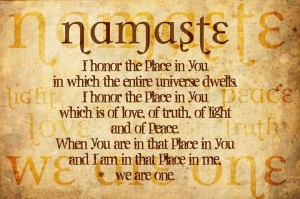 Eventually the mist cleared somewhat and we passed some more houses. DK told us if we saw kids to put our palms together and tell them “Namaste!”
Eventually the mist cleared somewhat and we passed some more houses. DK told us if we saw kids to put our palms together and tell them “Namaste!”
Informally this is a greeting that means hello and goodbye, similar to aloha. Formally it translates along the lines of “I solute the God within you.”
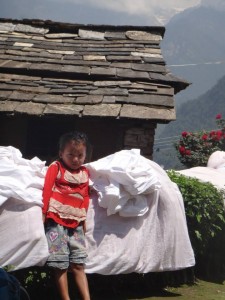
Namaste! The girls, except the one described below, tended to be more shy.
Photo credit: Eleanor Tresidder
Sure enough, most of them loved to play along and returned the greeting. DK was walking behind the group. We passed another kid, who after hearing “Namas-te!” from all of us, lit up like a Christmas tree when DK began chatting him up in Nepali. I turned around and lit up along with them, totally blown away. I asked DK later how long it took him to become so fluent, and modest as ever said he really wasn’t, that the boys (our Nepali guides and porters) knew what they could talk to him about and what they couldn’t. He was still learning every day. Well, he could have fooled me, and probably also that kid.
We stopped at our second tea house for lunch and more tea. From here we watched an avalanche of clouds roll down the mountainside. Lunch was delicious, fresh, local and organic. What could be better?
“I’m so glad this life still exists for somebody,” I remember saying.
Further up the trail we stopped again for, you guessed it, tea (chiyaa). Dovile made friends with a little girl who lived in the tea house. The little girl seemed to think we were so much fun she just had to dance for us. She giggled and swung her hips from side to side, hamming it up for the foreigners. She used whatever English words she knew and laughed when we answered her. She was so cute we regretted leaving, and looked forward to visiting again on the way down.
We ran out of daylight and had to don our headlamps before reaching Phakding (8,563 ft. / 2,610 m). Darkness brought out some spiders, and Amanda was not a fan. Hopping away from them interrupted her conversation with DK about books by Conn Iggulden. I was intrigued and made a note to add them to my reading list.
It wasn’t long after switching on the lights that we reached our home for the night and dropped our packs in the tea house common room. We were out of time to order dinner individually since all the food was made to order, so the group all shared our first yak cheese pizza, along with fries and some soup. Once we were all completely stuffed, they brought the menus out again and asked us to pick what we wanted for breakfast. (What?? You expect us to think about more food now?) This would become a post-meal-time ritual the rest of the trek. Eventually we learned what to expect on the menus and would consider what we wanted for the whole day at a point when we were still hungry. Or else we simply alternated between veggie momos and dal bhat.
There was cricket on TV, and I was mesmerized both by the cricket and the TV since I don’t have either at home. We met a couple of trekkers who were on their way down and asked them how it was. They looked much more… shall we say… worn than we did and we wondered what would look like by the time we were in their place.
Back in Surke we heard that two porter bags did not make it on either flight and would arrive the next day. It wasn’t until Phakding that we confirmed exactly whose bags were missing, because apparently some of the identifying prayer flags did not even last a day. Dovile and I paid the price for having such a heavy, crammed bag, as it was probably the ideal choice to abandon in favor of more fuel.
“Nobody say anything about my outfit tomorrow!” she joked.
We likely would have worn the same shirt three days in a row anyway, but having something different to sleep in and a toothbrush would have been nice.
The lodge where we would sleep was separate from the common room, and very beautiful. Everything was wood, down to the carved stair rail. There were three western style toilets down the hall from the rooms, with a bin in each for toilet paper we were not supposed to flush. Not having a sleeping bag was no problem. At most of the tea houses, they would provide us with pillows and big, heavy blankets. Those of us without sleeping bags got a couple extra at this place. I took stock of my day pack and was thrilled to see the bar of soap I forgot I tossed in there after forgetting to pack it in our porter bag before it was forcefully and irreversibly zipped that morning.
“There are no accidents!” I said to Ele as we washed our faces at the community sinks in the hallway.
So ended a long and wonderful day. I don’t think anyone had trouble sleeping that night.

